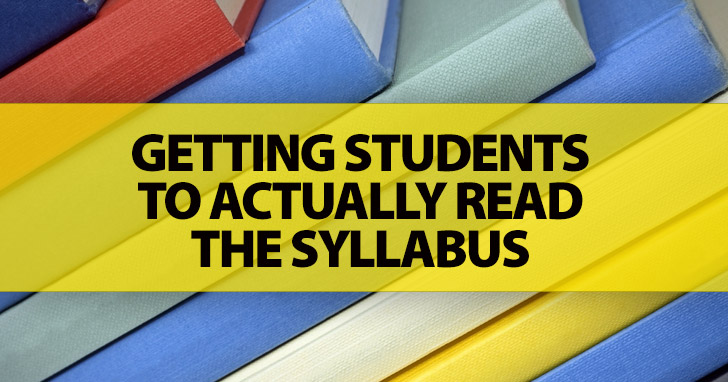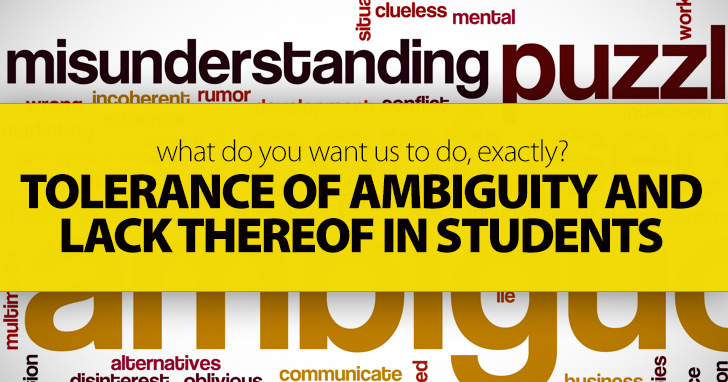First Things First: How To Get Your Students to Actually Read the Syllabus


Most notable today is the tendency of students to treat a college education as a commodity which they’ve purchased, and the quality of which—and the individual student’s grade—is solely in the responsibility of the instructor. Related to this “consumer” attitude is an intolerance of ambiguity, the demand to be told exactly what to do, in order to protect the precious grade, the student’s “investment.” This has resulted in a number of trends: for example, the expectation to provide increasingly detailed “rubrics” for each project which explain in excruciating detail its expectations and their relationship to the students’ overall grades.
In a personal experience, a few years ago I had a student in a graduate-level education course who claimed to “not understand” what to do in the design of a “webquest.” A webquest asks the student to visit a number of related websites, recording information from each, in order to investigate a problem. In other words, it is a research project incorporating online data. The problem was not that the student didn’t understand and admitted it: most students then had not yet had experience with such a project. Indeed, because I had anticipated some confusion, I gave out a list of detailed instructions on how to complete the project. Because the student still expressed confusion, I then provided a model that I created of a webquest investigating my own question on the effects of writing portfolios. This again issued the response the student didn’t know what to do, with the strong implication it was my fault for “not explaining well.” I then obliged by asking for the student’s topic and completing the first step for her. Not surprisingly, there was still feedback that the assignment was “confusing” and an implied demand that the project be eliminated--which the student stated explicitly was to protect her grade.
It is my position, however, that some ambiguity is part of an education, indeed may be the essential component. Development of critical thinking skills naturally involves learning new material that it is initially confusing, demanding one’s active engagement in the learning process in order to plan one’s original work that is not modeled completely on someone else’s. Students should approach the class expecting some ambiguity and lack of immediate understanding, and the teacher should guide students toward this acceptance.

Starting with clear instructions of the material but eventually turning control over the learning process to the students is a traditional teaching method called “scaffolding.” That is, the instructor provides temporary support as students progress in competence. In the webquest, the clear instructions, examples, and instructor completion of part of the assignment are all temporary “scaffolding” that teachers should be expected to provide, especially over unfamiliar material. The operative word, however, is “temporary.” Students are expected to actively engage in this learning process from the start so that they can gain enough understanding of the material to eventually progress independently. The problem is when the student “shuts down” and turns over all control to the instructor. The teacher should actively discourage this response. Explaining “too much” can create a passive learner who has not grappled with the material enough to truly understand it. Therefore, when students begin to show some understanding, the teacher should stop helping so much.
Along with the increasing demand of detailed instructions is the expectation for “examples”: students expect examples of almost all assignments, from essays to research projects to journal responses. Again, while a valued teaching method, excessive use of “examples” is problematic. For one, it’s not always necessary, especially with familiar assignments. While the instructor shouldn’t assume that all students have seen a webquest, it’s not at all unreasonable to expect they all know what a paragraph looks like. Scrambling up so many models is also an additional burden on the instructor, as not all student work is exemplary, and a model created by the teacher is often artificial. By nature teachers are not at the students’ level of development, and examples created by teachers on assignments can look forced. In a related concern is the potential for plagiarism. If the model is too close to the project students are expected to complete, the probability of students just copying the model increases. Teachers should therefore not yield to demands for examples in all cases. In addition, there is a need to explain what plagiarism is and the seriousness of the offense.
A main problem behind the demand to be told what to say and how to say it is students’ mistaken belief they have nothing original and of value to say. This notion is usually incorrect: almost everyone has some original interest and something of value to say about it. Therefore, wide latitude in the choice of topics for projects should be allowed. I’ve had students who have researched such “”nonacademic” topics as the process of recruiting professional football players and controversial topics such as whether a college education really delivers on its investment. Allowing this choice not only decreases the possibility of plagiarism, but student engagement is also increased. Students are more engaged with a project they care about and therefore work harder, learn more, and produce better work.
At some point in the process, often early on, the students begin to ask why: why is the instructor not telling us exactly what to do, how to do it, what her expectations are: why isn’t she doing her job? It is now time to discuss the nature of a college education. By telling students exactly what to do, the teacher is actually doing a large part of the student’s job, which is to grapple with the material, maybe get frustrated, feel confused, and deal with ambiguity in general. This is all part of the learning process. In dealing with these problems, students begin to develop critical thinking skills required in figuring out, for example, what they want to research and how to go about finding the answers to their questions. To take over the process completely is to rob students of this experience which is the very education they’ve paid me for (which they often remind of).
As for what I expect? The answer to that is often I honestly don’t know. The final products that students produce is ultimately in their control.
And often I’m pleasantly surprised.